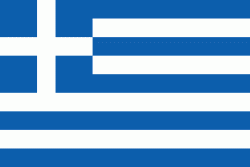Skiathos Island National Airport (Skiathos Airport 'Alexandros Papadiamantis')
Skiathos Alexandros Papadiamantis Airport is an airport on the island of Skiathos, Greece. Its 5,341 ft runway is able to accommodate aircraft up to the size of a Boeing 767-200. The runway is characterised as 'short and narrow'. Because of the uneven terrain on the island of Skiathos, Skiathos Airport was created by reclaiming land from the sea between Skiathos island and the smaller island of Lazareta (a former leper colony) effectively joining the two islands into one larger island, though it was however built on land already part of Skiathos. The place was chosen by a mechanic who lived in Volos. The airport is named after Alexandros Papadiamantis, a Greek novelist and native of the island.
The airport's short runway and its proximity to an adjacent public road have made it a popular destination for planespotters. It is often compared to Princess Juliana International Airport on Saint Maarten since both airports offer the public an ability to legally experience landing approaches and takeoffs at very close range.
The airport first operated in 1972.
A passenger terminal and a new control tower was constructed in 1988. In 2001 the terminal was closed down by a minor earthquake, and a new passenger terminal opened in 2002, to better accommodate the growing number of passengers.
From 2019, as part of the Fraport construction works the airport has 2 current terminals. Terminal 1 was reconstructed and is currently the Domestic Terminal, and Terminal 2 is for international arrivals.
Skiathos Airport has no jetways, meaning, prior to the 2016 work, passengers walked the short distance from the aircraft to the terminal building, now, a collection of buses drive passengers the short distance.
From 2014, there was extension to the runway and a new taxiway was introduced. The runway was extended by 110 metres on the north side of the airport. An extension was added to the taxiway, for an additional 4–5 parking stands. The airport has the capacity for only 6 additional parking stands. This opened in 2016.
The island has only a roundabout at the airport, and 1 set of Traffic lights at the end of the runway.
In December 2015, the privatization of Skiathos Island National Airport and 13 other regional airports of Greece was finalised with the signing of the agreement between the Fraport AG/Copelouzos Group joint venture and the state privatization fund. "We signed the deal today," the head of Greece's privatization agency HRADF, Stergios Pitsiorlas, told Reuters. According to the agreement, the joint venture will operate the 14 airports (including Skiathos Island National Airport) for 40 years as of 11 April 2017.
The airport's short runway and its proximity to an adjacent public road have made it a popular destination for planespotters. It is often compared to Princess Juliana International Airport on Saint Maarten since both airports offer the public an ability to legally experience landing approaches and takeoffs at very close range.
The airport first operated in 1972.
A passenger terminal and a new control tower was constructed in 1988. In 2001 the terminal was closed down by a minor earthquake, and a new passenger terminal opened in 2002, to better accommodate the growing number of passengers.
From 2019, as part of the Fraport construction works the airport has 2 current terminals. Terminal 1 was reconstructed and is currently the Domestic Terminal, and Terminal 2 is for international arrivals.
Skiathos Airport has no jetways, meaning, prior to the 2016 work, passengers walked the short distance from the aircraft to the terminal building, now, a collection of buses drive passengers the short distance.
From 2014, there was extension to the runway and a new taxiway was introduced. The runway was extended by 110 metres on the north side of the airport. An extension was added to the taxiway, for an additional 4–5 parking stands. The airport has the capacity for only 6 additional parking stands. This opened in 2016.
The island has only a roundabout at the airport, and 1 set of Traffic lights at the end of the runway.
In December 2015, the privatization of Skiathos Island National Airport and 13 other regional airports of Greece was finalised with the signing of the agreement between the Fraport AG/Copelouzos Group joint venture and the state privatization fund. "We signed the deal today," the head of Greece's privatization agency HRADF, Stergios Pitsiorlas, told Reuters. According to the agreement, the joint venture will operate the 14 airports (including Skiathos Island National Airport) for 40 years as of 11 April 2017.
| IATA Code | JSI | ICAO Code | LGSK | FAA Code | |
|---|---|---|---|---|---|
| Telephone | Fax | ||||
| Home page | Hyperlink |
Map - Skiathos Island National Airport (Skiathos Airport 'Alexandros Papadiamantis')
Map
Country - Greece
 |
 |
| Flag of Greece | |
Greece is considered the cradle of Western civilization, being the birthplace of democracy, Western philosophy, Western literature, historiography, political science, major scientific and mathematical principles, theatre and the Olympic Games. From the eighth century BC, the Greeks were organised into various independent city-states, known as poleis (singular polis), which spanned the Mediterranean and the Black Sea. Philip II of Macedon united most of present-day Greece in the fourth century BC, with his son Alexander the Great rapidly conquering much of the ancient world, from the eastern Mediterranean to the North Western parts of India. The subsequent Hellenistic period saw the height of Greek culture and influence in antiquity. Greece was annexed by Rome in the second century BC, becoming an integral part of the Roman Empire and its continuation, the Byzantine Empire, which was culturally and linguistically predominantly Greek.
Currency / Language
| ISO | Currency | Symbol | Significant figures |
|---|---|---|---|
| EUR | Euro | € | 2 |
| ISO | Language |
|---|---|
| EN | English language |
| FR | French language |
| EL | Greek language |















